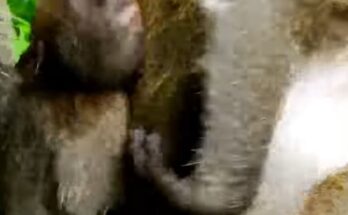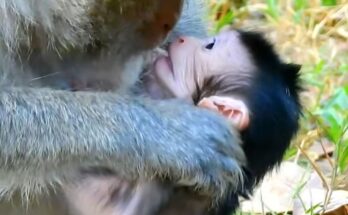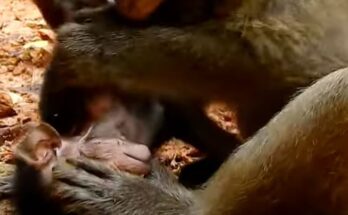The animal kingdom often reveals fascinating and sometimes puzzling behaviors, particularly between mothers and their offspring. Observing a mother monkey seemingly mistreating her baby can be distressing, especially when the baby cries loudly and appears to suffer. However, such behavior might not always be as cruel or heartless as it seems at first glance. To understand why a mother monkey might act harshly toward her baby, we must explore various biological, social, and environmental factors that influence maternal behaviors in monkeys.
Understanding Primate Maternal Behavior
In most primate species, maternal care is essential for the survival and development of infants. Mother monkeys typically demonstrate significant attachment and investment in their offspring, providing nourishment, protection, and social learning. However, their actions might sometimes appear harsh or even aggressive to an outside observer. These behaviors, while unsettling to watch, often serve specific purposes in the complex world of primate life.
Possible Reasons for Harsh Maternal Behavior
- Discipline and Social Learning
Mother monkeys play a crucial role in teaching their babies how to navigate the world, which includes understanding social hierarchies and boundaries. Sometimes, what appears to be harsh behavior could be a form of discipline meant to correct the infant’s actions. For example, if the baby ventures too far or engages in inappropriate behavior, the mother may act sternly to teach the infant essential survival skills. While the baby’s cries might evoke sympathy in human observers, such discipline is often necessary for the baby’s long-term well-being. - Stress and Environmental Pressures
Monkeys, like humans, are influenced by their environment. If a mother monkey is experiencing stress due to a lack of food, threats from predators, or social tension within the group, her behavior may become harsher. Stress can lead to a decrease in patience and nurturing behavior, causing her to react aggressively or indifferently toward her baby. - Health Issues or Fatigue
A mother’s ability to care for her baby is also influenced by her physical health. If the mother is unwell, injured, or malnourished, she may lack the energy to provide adequate care. This might result in behaviors that seem neglectful or rough. In some cases, the mother’s actions could stem from exhaustion, especially if the infant is particularly demanding or cries excessively. - Rejection or Abandonment
In rare cases, a mother monkey may reject her baby entirely. This can happen for several reasons, such as the baby being born weak, ill, or deformed. From an evolutionary standpoint, this behavior may increase the mother’s chances of survival and reproduction in the future, as investing in a baby with a low likelihood of survival can be detrimental in a resource-scarce environment. While heartbreaking to witness, this behavior is a natural, albeit harsh, strategy for species survival. - Dominance and Group Dynamics
Primate social groups are often hierarchical, and dominance can play a significant role in maternal behavior. If the mother is low-ranking, she may face aggression from higher-ranking females or males in the group, which can make her more anxious and reactive. Her harsh behavior toward her baby could be an indirect consequence of her subordinate position within the group.
The Baby’s Perspective
From the baby monkey’s perspective, the mother’s harsh behavior can be extremely distressing. Babies cry as a way to communicate their needs, express discomfort, or seek attention. When a mother monkey disciplines or ignores her baby, the infant’s loud cries are a natural response to the perceived threat or neglect. However, these cries also serve an evolutionary purpose, as they can sometimes draw the attention of other group members who might intervene or offer support.
What Can Be Done?
For those observing such interactions in a zoo or a conservation setting, it’s important to approach the situation with an understanding of natural animal behavior. If the mother’s actions appear to put the baby in immediate danger, it might be necessary to consult with animal care professionals or wildlife experts. In the wild, however, such behaviors are typically part of the natural order and should not be interfered with unless absolutely necessary.
Emotional Response and Human Perception
As humans, we are naturally empathetic creatures, and watching a baby animal suffer can be heart-wrenching. However, it’s crucial to recognize that the behaviors we perceive as “bad” may serve specific purposes in the animal’s natural context. What seems harsh or cruel to us might be a form of tough love or a reflection of environmental pressures beyond the mother’s control.
Conclusion
While it’s undeniably sad to see a baby monkey crying or being treated harshly by its mother, such behaviors are often a part of the complex dynamics of primate life. They may serve as tools for discipline, survival, or adaptation to stressful circumstances. By understanding these behaviors, we can better appreciate the intricate balance of nature and the challenges faced by animals in their struggle for survival. Ultimately, empathy combined with knowledge can help us view these moments not as acts of cruelty but as reflections of the natural world’s complexity.


